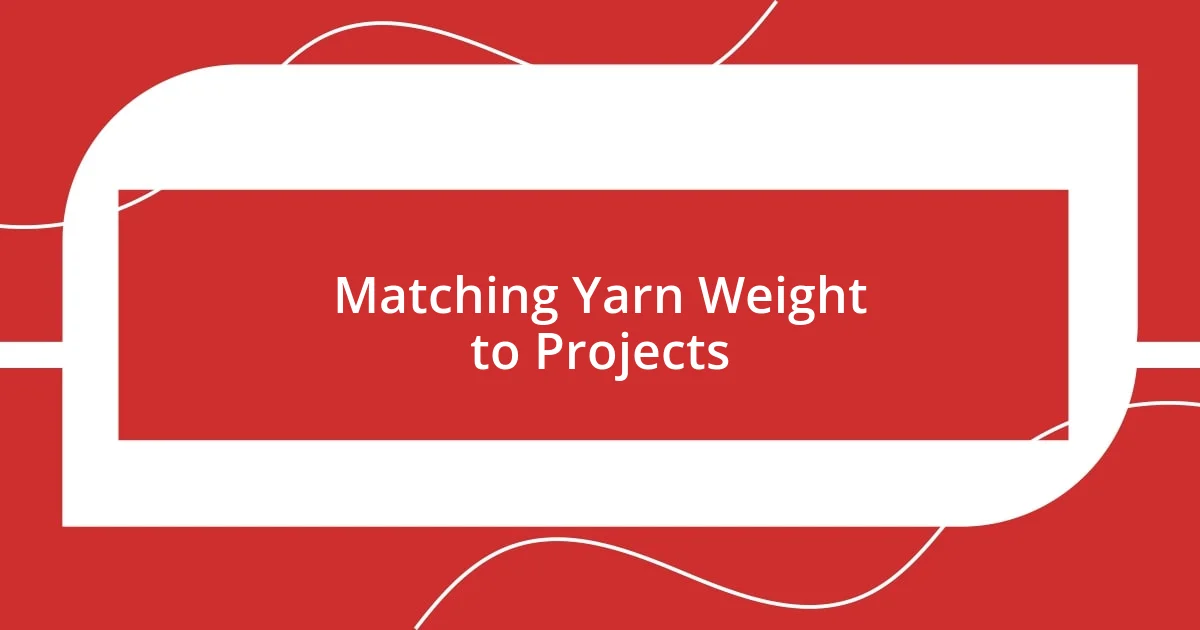Key takeaways:
- Yarn weight significantly influences the project’s aesthetics and functionality, making it essential to consider intended use and gauge.
- Common mistakes in yarn selection include focusing solely on color, misjudging texture, and neglecting gauge swatches, which can lead to unsatisfactory results.
- Testing yarn weight through creating gauge swatches and comparing different yarns enhances the crafting experience and assures the right choice for the desired project outcome.

Understanding Yarn Weight Basics
Yarn weight is essentially a classification system that indicates the thickness of a yarn, which directly affects the project’s outcome. When I first ventured into knitting, I was overwhelmed by the various yarn weights available—ranging from delicate lace to chunky. Isn’t it fascinating how such a simple categorization can shape the whole aesthetic and functionality of your finished piece?
Each yarn weight has its designated purpose. For instance, I remember starting a blanket with worsted weight yarn, thinking it would be the perfect warmth. I soon discovered that the drape and texture I envisioned didn’t quite come together the way I’d hoped. Now, I always ask myself: how do I want my project to feel? This question has become my guiding principle in selecting the right yarn weight.
Understanding yarn weight also involves acknowledging the recommended gauge for a pattern. It may sound intimidating, but think of it as a personal guide to achieving your vision. I’ve learned the hard way, through multiple frogged projects, how crucial it is to pay attention to these details. Why not take your time with a swatch? It’s a small investment that can save you from potential frustration later on.

Types of Yarn Weights Explained
When exploring the different types of yarn weights, it’s interesting to see how they influence both the look and feel of your finished project. I remember the first time I picked up a super bulky yarn; it felt like a game-changer! The stitches seemed to work up in a flash, yet the resulting piece had a bombastic presence that was dramatically different from anything I’d created before. Understanding these distinctions helps me decide not just on the intended use but also the emotional essence of my project.
Here’s a breakdown of yarn weight categories that can guide you:
- Lace Weight: Delicate and wispy, perfect for shawls or light garments.
- Fingering Weight: Often used for fine knits, this weight is ideal for intricate patterns or lightweight sweaters.
- Sport Weight: Strikes a balance, great for summer tops or baby clothes.
- Worsted Weight: Versatile and popular; it’s my go-to for blankets and warm sweaters.
- Bulky Weight: Great for quick projects like chunky scarves, delivering substantial warmth and style.
- Super Bulky: Thick and heavy, perfect for cozy blankets or oversized garments that make a statement.
Understanding the nuances of these categories can lift some of that initial overwhelming feeling, making your yarn weight selection feel like second nature. I’ve learned to love the trial and error that comes with each new project; it’s all part of the creative journey!

Factors Affecting Your Yarn Choice
Choosing the right yarn weight involves considering several key factors that can tremendously impact your project. First and foremost, the intended use of your project plays a major role. For example, I love making baby clothes, and I’ve learned the hard way that I need soft, breathable yarns, like sport weight, to ensure comfort for tiny ones. On the other hand, if I’m crafting something cozy for the winter, I reach for bulky yarn to deliver that enveloping warmth. It’s all about matching the yarn weight to the practical needs of your project!
Another significant factor is the pattern’s recommended yarn weight and gauge. I vividly recall my enthusiasm while planning a summer cardigan; I just had to use a lightweight yarn! However, when I overlooked the gauge in the pattern, the cardigan ended up far too large and floppy. This little mishap taught me the importance of following the recommendations closely. When I take the time to fully comprehend the gauge, I feel far more empowered in my crafting choices.
Environmental factors can also dictate yarn weight selection. For instance, I often knit during summer road trips and find that lighter yarns are far more comfortable to work with. At times, I even switch to fingering weight yarn while traveling because it offers portability and allows me to create intricate designs without the bulk. I’ve found that considering the environment helps streamline my crafting experiences, improving not only how I work but also enhancing my overall joy in the process.
| Factor | Considerations |
|---|---|
| Intended Use | Choose yarn based on the final product’s need for drape, softness, or warmth. |
| Pattern Recommendation | Follow the suggested yarn weight and gauge to avoid sizing issues. |
| Environmental Factors | Consider portability and comfort based on the setting in which you’ll be knitting or crocheting. |

How to Read Yarn Labels
Reading yarn labels can seem daunting at first, but I’ve found it to be quite intuitive with some practice. Each label typically indicates the yarn weight, which is usually represented with a number or a symbol. For instance, I often refer to the weight as a clue for my projects; if I see a “4” or a stylized ball of yarn, I know I’m dealing with worsted weight, which is my trusted foundation for many projects.
I always pay close attention to the material composition listed on the label as it significantly affects the yarn’s drape and texture. For example, I remember working with a cotton blend that felt fantastic for summer projects but had a completely different feel than wool, especially during colder months. Understanding these materials helps me choose not just based on aesthetics, but also comfort and functionality—questions like: “Will this yarn breathe well?” or “Is it soft enough for a baby blanket?” come to mind during my selection process.
Lastly, I never overlook the care instructions that come with the yarn label. I recall making a gorgeous sweater with a yarn that eventually shrank after a careless wash. Learning to read those care symbols has since saved me from heartache and disappointment. It’s almost like getting a sneak peek into how my finished product will behave—will it hold its shape? Can I toss it in the washer? This knowledge adds an extra layer of joy and satisfaction to my crafting!

Matching Yarn Weight to Projects
When it comes to matching yarn weight to projects, I often think about the emotional response I want from the finished piece. For instance, I recently knitted a light shawl for a summer wedding. I carefully chose a lace weight yarn that not only balanced elegance with comfort but also unfurled beautifully with each stitch, enhancing the entire experience of crafting. Isn’t it amazing how the right yarn can elevate the final product?
I remember a time when I decided to make a plush blanket as a gift for a close friend. My initial thought was to use a worsted weight yarn, believing it would produce a cozy result. However, after reconsidering, I switched to a super bulky yarn that added a layer of softness and warmth I hadn’t anticipated. The joy on my friend’s face when they received that blanket—wrapped in a hug of warmth—was all the validation I needed. It truly illustrates how choosing the right yarn weight isn’t just about practicality; it’s also about creating moments and memories.
Additionally, I find it crucial to support my yarn choices with practicality. For example, I recently started a beanie project that I wanted to finish quickly. Instead of reaching for my usual worsted weight, I opted for a thicker, super bulky yarn. The satisfaction of completing that project in record time was exhilarating! It felt like a small victory, reinforcing my belief that matching yarn weight to the project not only enhances the experience but also aligns with my creative goals. Wouldn’t you agree?

Common Mistakes in Yarn Selection
One common mistake I often see is choosing yarn based solely on color without considering the weight. I remember being captivated by a vibrant skein of yarn that seemed perfect for my project, only to realize later that it was a delicate lace weight. The result? A frustratingly flimsy scarf instead of the cozy wrap I envisioned. Have you ever faced a similar dilemma? Color can be intoxicating, but I’ve learned that weight matters just as much—if not more.
Another error that can lead to disappointment is misjudging the yarn’s texture in relation to the intended use. I recall starting a baby blanket with a yarn that looked beautiful but felt quite rough to the touch. The moment I handed it over, I could see my friend’s concern that it wouldn’t be gentle enough for her little one. That experience taught me the importance of not just selecting a yarn that looks good but also feels right. How can we create something cherished if the final product doesn’t match our emotional expectations?
Finally, I’ve noticed that many crafters overlook the importance of gauge swatches. I used to skip this step—thinking I could wing it, but I paid the price by completing a sweater only to find it two sizes too big. The feeling of holding that oversized garment and realizing my mistake was disheartening. Now, I embrace the gauge swatch as a valuable ally in my crafting journey. It may seem tedious, but wouldn’t you agree that investing a little time initially helps avoid letting our hard work go to waste?

Tips for Testing Yarn Weight
When testing yarn weight, I find that creating a gauge swatch is invaluable. It’s a small sample that reveals how many stitches and rows fit into a certain measurement, typically four inches. I remember crafting a swatch for a cowl and finding that my yarn was unexpectedly bulkier than anticipated—this simple step saved me from an awkwardly shaped project. Have you ever had a yarn surprise?
I also recommend observing how a yarn behaves when you knit or crochet it. I often run my fingers through different yarns and notice how they drape and stretch. For example, I once worked with a cotton yarn that looked promising in the skein but felt stiff in my hands, which drastically altered my expectations for the project. Isn’t it fascinating how the tactile experience can shift your perspective on a yarn?
Finally, don’t hesitate to compare different yarns side by side. When I was choosing yarn for a summer top, I laid out several options, each in a similar weight category, and examined their visual and tactile differences. This hands-on approach made it clear which yarn would create the light, airy feel I desired for the garment. Have you ever approached a selection this way? It’s remarkable how a little comparison can lead to a clearer vision for your project.















